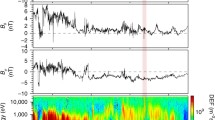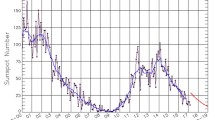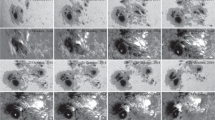Abstract
The magnetic reconnection of magnetosphere and the magnetospheric space storms (including magnetospheric substorm, magnetic storm, magnetospheric particle storm) has long been one of the most challenging subjects in the solar-terrestrial physics. The reconnection mechanism and global triggering process of the magnetospheric space storms are still unclear up to now. Based on the Double Star Program (DSP) and Cluster joint measurements, we have observed the solar wind density hole, the component magnetic field reconnection in the magnetopause, the structures of magnetic storm ring current, global and multi-scale driven and triggering processes of magnetospheric substorm. In this paper we will briefly introduce these results.
Similar content being viewed by others
References
Cowley S W H. Comments on the merging of non anti-parallel magnetic fields. J Geophys Res, 1976, 81: 3455–3458
Luhmann J G, Walker R J, Russell C T, et al. Patterns of potential magnetic field merging sites on the dayside magnetopause. J Geophys Res, 1984, 89: 1739–1742
Crooker N U. Dayside merging and cusp geometry. J Geophys Res, 1979, 84: 951–959
Sonnerup B U, Paschmann O, Papamastorakis G, et al. Evidence for magnetic field reconnection at the Earth’s magnetopause. J Geophys Res, 1981, 86: 10049–10067
Lui A Y. Current controversies in magnetospheric physics. Rev Geophys, 2001, 39: 535
Liu Z X, Escoupet C P, Pu Z Y, et al. The Double Star mission. Ann Geophys, 2005, 23: 2707–2712
Parks G K, Lee E, Hozer F, et al. Larmor radius size density holes discovered in the solar wind upstream of Earth’s bow shock. Phys Plasmas, 2006, 13: 050701
Pu Z Y, Xiao C J, Zhang X G, et al. Double Star TC-1 observation of magnetic reconnection at the dayside magnetopause: A preliminary study. Ann Geophysicae, 2005, 23: 2897–2901
Pu Z Y, Zong Q G, Xiao C J, et al. Multiple flux rope events at the high-latitude magnetopause: Cluster/rapid observation on January 26, 2001. Surveys in Geophys, 2005, 26(1–3): 193–214
Xiao C J, Pu Z Y, Wei Y, et al. Multiple flux rope events at the magnetopause observations by TC1 on Mar.18, 2004. Ann Geophys, 2005, 23: 2897–2901
Wang J, Dunlop M W, Pu Z Y, et al. TC1 & Cluster observation of an FTE on 4 January 1, 2005: A close conjunction. Geophys Res Lett, 2007, 34: L03106, doi:10.1029/2006GL028241
Pu Z Y, Zhang X G, Wang X G, et al. Global view of dayside magnetic reconnection with the dusk-dawn IMF orientation: a statistical study for Double Star and Cluster data. Geophys Res Lett, 2007, 34: L20101, doi:10.1029/GL030336
Petrukovich A A, Zhang T L, Baumjohann W, et al. Oscillatory magnetic flux tube slippage in the plasma sheet. Ann Geophys, 2006, 24: 1695–1704
Lu L, McKenna-Lawlor S, Barabash S, et al. Electron pitch angle variations recorded at the high magnetic latitude boundary layer by the NUADU instrument on the TC-2 spacecraft. Annales Geophysicae, 2005, 23: 2953–2959
McKenna-Lawlor S, Balaz J, Barabash S, et al. The energetic NeUtral Atom Detector Unit (NUADU) for China’s Double Star Mission and its calibration. Nuclear Instruments and Methods in Physics Research Section A, 2004, 503L: 311–322
Lu L, McKenna-Lawlor S, Barabash S, et al, Sheet stretching accompanied by field aligned energetic ion fluxes observed by the NUADU instrument aboard TC-2. Chin Sci Bull, 2007, 52(12): 1719–1723
Cao J, Yang J, Yan C, et al. The observations of high energy electrons and associated waves by DSP satellites during substorm. Nuclear Phys B, 2007, 166(suppl): 56–61
Cao J B, Liu Z X, Yang J Y, et al. First results of Low Frequency Electromagnetic Wave Detector. Ann Geophys, 2005, 23: 2803–2811
Liu Z X, Zhang L Q, Shen C, et al. Global and multi-scale processes of magnetospheric substorm driven and trigger: “Front model” of substorm trigger, 2006 COSPAR, (solicited)
Zhang L Q, Liu Z X, Ma Z W, et al, Effect of the upflow ions on the near-Earth FAC. Sci China Ser E-Tech Sci, 2007, 50(5): 1–8
Zhang L Q, Liu Z X, Ma Z W, et al. The continuous tailward flow in the near-Earth magnetotail explored by TC-1. Chin Sci Bull, 2007, 52(1): 1–6
Zhang L Q, Liu Z X, Wang J Y, et al. The distribution characteristics of the near-Earth plasma flow explored by TC-1. Chin Sci Bull, 2007, 53(7): 843–847
Liu Z X, Zhang L Q, Ma Z W, et al The statictical characteristics of the tailward flows in the near-Earth region explored by TC-1. Chin J Geophys, 2007, 50(3): 655–661
Author information
Authors and Affiliations
Corresponding author
Additional information
Supported by the National Natural Science Foundation of China: DSP-Cluster six point coordinated exploration and research (Grant No. 40620130094), Multiple temporal-spatial scale physical processes of geospace storms (Grant No. 40390150), Driven process of multiple space regions and muitiple temporal-spatial-scale of geospace Storms (Grant No. 40390151)
Rights and permissions
About this article
Cite this article
Liu, Z., Pu, Z., Cao, J. et al. New progress of Double Star-Cluster joint exploration and study. Sci. China Ser. E-Technol. Sci. 51, 1565–1579 (2008). https://doi.org/10.1007/s11431-008-0267-6
Received:
Accepted:
Published:
Issue Date:
DOI: https://doi.org/10.1007/s11431-008-0267-6




